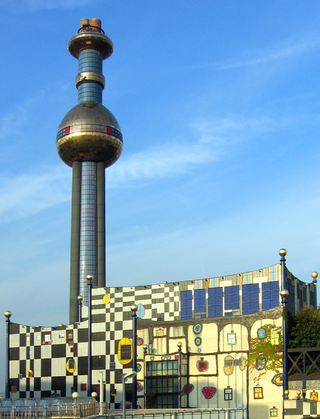
Incineration is a waste treatment process that involves the combustion of substances contained in waste materials. Industrial plants for waste incineration are commonly referred to as waste-to-energy facilities. Incineration and other high-temperature waste treatment systems are described as "thermal treatment". Incineration of waste materials converts the waste into ash, flue gas and heat. The ash is mostly formed by the inorganic constituents of the waste and may take the form of solid lumps or particulates carried by the flue gas. The flue gases must be cleaned of gaseous and particulate pollutants before they are dispersed into the atmosphere. In some cases, the heat that is generated by incineration can be used to generate electric power.
A chimney is an architectural ventilation structure made of masonry, clay or metal that isolates hot toxic exhaust gases or smoke produced by a boiler, stove, furnace, incinerator, or fireplace from human living areas. Chimneys are typically vertical, or as near as possible to vertical, to ensure that the gases flow smoothly, drawing air into the combustion in what is known as the stack, or chimney effect. The space inside a chimney is called the flue. Chimneys are adjacent to large industrial refineries, fossil fuel combustion facilities or part of buildings, steam locomotives and ships.

The Richard L. Hearn Generating Station is a decommissioned electrical generating station in Toronto, Ontario, Canada. The plant was originally fired by coal, but later converted to burn natural gas. The plant has been described as "Pharaonic in scale", and encompasses 650 thousand cubic metres of space—large enough to fit 12 Parthenons inside.

Stewartby is a model village and civil parish in Bedfordshire, England, originally built for the workers of the London Brick Company. The village was designed and built to the plans of the company's architect Mr F W Walker, laid out on 'Garden City' principle, a later and more modern development than such better-known Victorian model villages as Saltaire. Started in 1926, Stewartby is also a later model than Woodlands which was first planned in 1905. The later retirement bungalow development of the 1950s and 1960s with the pavilion community centre in their midst was designed by the neo-Georgian architect Professor Sir Albert Richardson. Today, Stewartby parish also includes Kempston Hardwick.

Kwai Chung Incineration Plant was one of four incineration plants in Hong Kong. The plant was built on a 1.4 hectares of reclaimed land along Gin Drinkers Bay, Kwai Chung, near Pillar Island and the Rambler Channel.
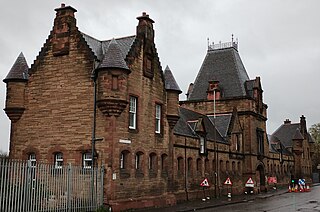
Powderhall is an area lying between Broughton Road and Warriston Road in the north of Edinburgh, the Scottish capital. Until recently it was best known for Powderhall Stadium, a greyhound racing track, which has now closed. The stadium also played host to motorcycle speedway racing from 1977 to 1995, as home to the Edinburgh Monarchs, who have since relocated to Armadale. The Powderhall Sprint, first held in 1870, was a professional footrace with handicapping of the runners. It continues, since 1999, as the New Year Sprint and is now held at Musselburgh Racecourse.
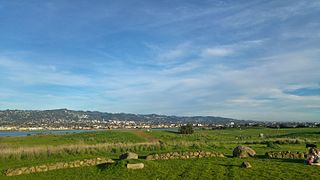
César Chávez Park is a 90 acres (36 ha) city park of Berkeley, California named after César Chávez. It can be found on the peninsula on the north side of the Berkeley Marina in the San Francisco Bay and is adjacent to Eastshore State Park.

The Allington Quarry Waste Management Facility is an integrated waste management centre in Allington, Kent. It is the site of the Allington Energy from Waste (EfW) Incinerator. The incinerator is owned by FCC Environment as Kent Enviropower. The facility, which has involved an investment of over £150 Million, is able to process 500,000 tonnes per annum of waste and has the ability to produce 40MW of power. The facility takes non-hazardous waste from households and businesses in Kent and the surrounding area for recycling and energy recovery. Materials separated by householders are sorted and sent for recycling, with the remainder being used to generate electricity to power the facility and for the local supply network.
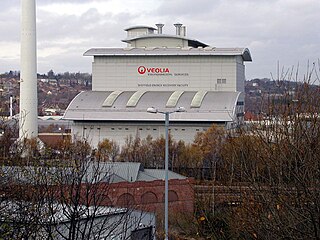
The Sheffield Energy Recovery Facility, also known as the Energy from Waste Plant, is a modern incinerator which treats Sheffield's household waste. It is notable as it not only provides electricity from the combustion of waste but also supplies heat to a local district heating scheme, making it one of the most advanced, energy efficient incineration plants in the UK. In 2004, the district heating network prevented 15,108 tonnes of CO2 from being released from buildings across the city, compared to energy derived from fossil fuels. The incinerator is a 'static asset' owned by Sheffield City Council and operated by Veolia Environmental Services under a 35 year integrated waste management contract (IWMC)/PFI contract.

Victoria Park Market is a cluster of galleries, workshops, studios, offices, restaurants and retail shops as well as a gym and Pilates Studio in Auckland, New Zealand. The precinct is housed in a former waste depot and incinerator complex. It is located in Freemans Bay and its name derives from the adjacent Victoria Park which was created in 1905 and named after the late Queen who had died four years earlier.

The Newhaven ERF is an incinerator, in the town of Newhaven in the English county of East Sussex, for the treatment of up to 210,000 tonnes per annum of the county's municipal solid waste. The facility, built by Veolia Environmental Services, was approved by planners at the Conservative-controlled East Sussex County Council.

EcoPark is a waste-to-energy plant which burns waste from several London boroughs to provide electricity for the National Grid. It is located on the River Lee Navigation and bordered by the North Circular Road, in Edmonton in the London Borough of Enfield. It is also known as Edmonton EcoPark.

Teesside Energy from Waste plant is a municipal waste incinerator and waste-to-energy power station, which provides 29.2 megawatts (MW) of electricity for the National Grid by burning 390,000 tonnes of household and commercial waste a year. It is located on the River Tees at Haverton Hill, east of Billingham in North East England. Developed and built by NEM, a subsidiary of Northumbrian Water, the initial plant replaced the Portrack Incinerator and opened in 1998. Subsequently, the facility became part of SITA, now Suez.

Horn Island Chemical Warfare Service Quarantine Station, also known as the Horn Island Testing Station, was a U.S. biological weapons testing site during World War II. It was located on Mississippi's Horn Island and opened in 1943. When the war ended, the facility was closed.
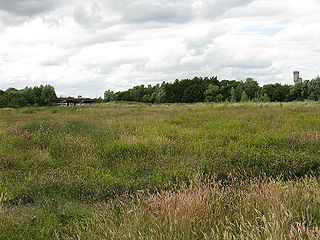
The Portrack Incinerator was a municipal waste incinerator and waste-to-energy power station situated on the River Tees at Portrack in Stockton-on-Tees in County Durham, England.

Stoke EfW is a large incineration plant in the Sideway area of Stoke-on-Trent, England. It burns municipal waste and in the process produces electricity for the National Grid.

Walter Burley Griffin Incinerator is a heritage-listed former incinerator at 10A Milford Street, Ipswich, City of Ipswich, Queensland, Australia. It was designed by Walter Burley Griffin and built from 1936 to 1940. It is also known as The Incinerator Theatre. It was added to the Queensland Heritage Register on 21 October 1992.

The Beitou Refuse Incineration Plant is an incinerator in Zhoumei Borough, Beitou District, Taipei, Taiwan.
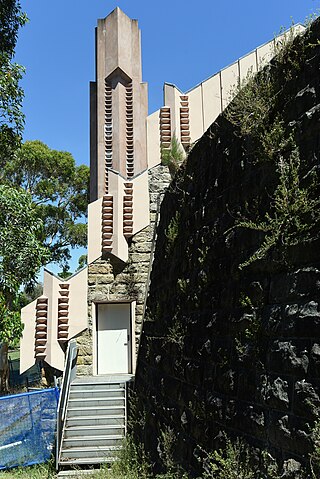
The Walter Burley Griffin Incinerator is a heritage-listed former incinerator and now art gallery, artists studios and public recreation area at 2 Small Street, Willoughby, City of Willoughby, Sydney, New South Wales, Australia. It was designed in partnership between Walter Burley Griffin and Eric Nicholls and built from 1933 to 1934 by Reverberatory Incinerator and Engineering Company and Nisson Leonard-Kanevsky. It is also known as Willoughby Municipal Incinerator. The property is owned by the Willoughby City Council. It was added to the New South Wales State Heritage Register on 2 April 1999.

Allerton waste recovery park is a waste recovery and incineration site located on a former quarry at Allerton Mauleverer, near Knaresborough, England. It is operated by AmeyCespa on behalf of North Yorkshire County Council and City of York Council, the site is capable of handling 320,000 tonnes of household waste per year.




















